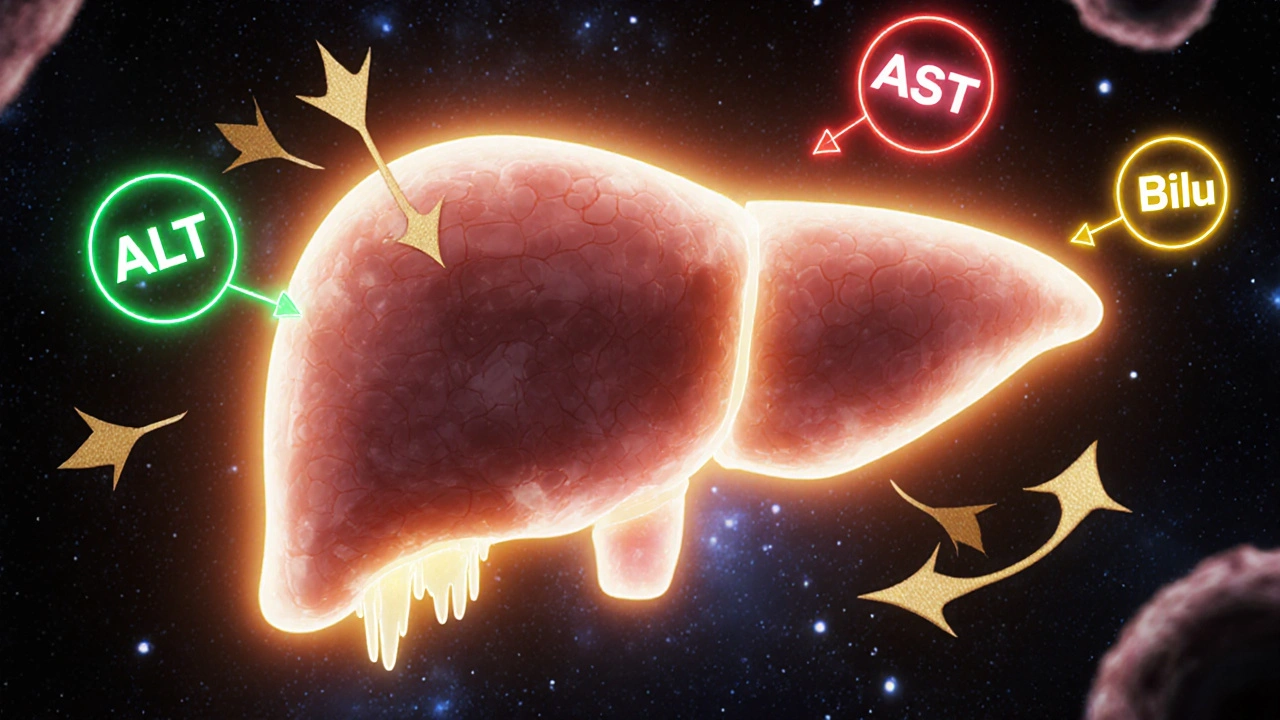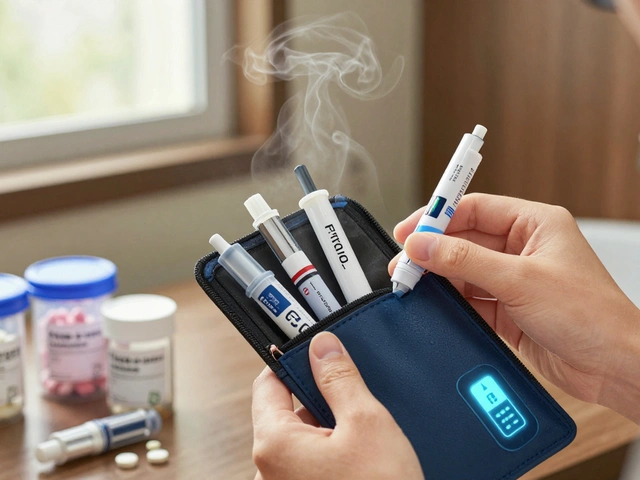When your doctor orders a liver function test, it’s not because they think your liver is broken. It’s because something in your blood is sending a quiet alarm - maybe fatigue, a strange ache under your ribs, or just an odd result from a routine checkup. But what do ALT, AST, and bilirubin actually tell you? And why does one number being high mean something totally different than another?
What Liver Function Tests Really Measure
The name "liver function tests" is misleading. These tests don’t measure how well your liver is filtering toxins or making bile. They measure damage. When liver cells get injured, they leak enzymes into the bloodstream. The higher the level, the more cells are damaged - but not always how badly the liver is failing.
The main players are ALT (alanine aminotransferase), AST (aspartate aminotransferase), ALP (alkaline phosphatase), GGT (gamma-glutamyl transferase), and bilirubin. Albumin and prothrombin time are also part of the full panel, but they’re different - they show how well the liver is still working, not just how much it’s been hurt.
Reference ranges vary by lab, but typical values are:
- ALT: 7-55 U/L
- AST: 8-48 U/L
- Bilirubin (total): 3-17 μmol/L
- ALP: 40-129 U/L
- Albumin: 35-50 g/L
But here’s the catch: normal doesn’t mean healthy. About 10-15% of people with perfectly fine livers have ALT or AST levels slightly above the "normal" range. Obesity raises these numbers naturally - people with a BMI over 30 often have ALT and AST levels 10-15% higher than those with a healthy weight. So if you’re overweight and your ALT is 60, that might just be your baseline, not a red flag.
ALT vs AST: The Clues in the Ratio
ALT is mostly found in the liver. AST is in the liver, heart, muscles, and even red blood cells. That’s why ALT is a cleaner signal of liver damage. If ALT is high and AST is normal, your liver is likely the problem. But when both are up, the ratio between them tells the real story.
If AST is more than twice as high as ALT - say, AST 120, ALT 50 - you’re looking at alcohol-related liver injury. This pattern shows up in 90% of people with alcoholic hepatitis. The reason? Alcohol damages liver cells in a way that releases more AST than ALT. In fact, if AST is over 500 U/L, alcohol alone is unlikely to be the cause - think acetaminophen overdose or severe viral hepatitis.
If ALT is higher than AST - say, ALT 200, AST 100 - it’s more likely viral hepatitis (like hepatitis A or B), nonalcoholic fatty liver disease (now called MASLD), or a drug reaction. In MASLD, ALT is often 1.5 to 2 times higher than AST. This pattern is so common in people with obesity and insulin resistance that doctors now use it as a clue even before imaging.
And here’s something few people know: ALT sticks around longer than AST. ALT’s half-life is about 47 hours. AST’s is only 18. So if you had a sudden liver injury - say, from a drug reaction - AST might drop back to normal in a few days, but ALT could stay high for over a week. That’s why doctors check both: AST tells you about recent damage, ALT tells you it’s still ongoing.
Bilirubin and the Cholestasis Signal
Bilirubin is the yellow pigment from broken-down red blood cells. Your liver normally processes it and sends it out in bile. When bile flow gets blocked - from gallstones, tumors, or inflammation - bilirubin backs up into the blood. That’s when you see jaundice: yellow skin, dark urine, pale stools.
But bilirubin doesn’t work alone. It’s always checked with ALP and GGT. If bilirubin is high and ALP is high too - especially if ALP is more than three times the upper limit - you’re looking at cholestasis. That means something is blocking the bile ducts.
Here’s a key trick: if ALP is high but GGT is normal, the problem isn’t your liver. It’s your bones. ALP is made by liver cells and bone cells. A broken rib, Paget’s disease, or even growing bones in teens can raise ALP without touching the liver. GGT is liver-specific. If GGT is up, the liver is involved. If it’s normal, look elsewhere.
Isolated bilirubin elevation - say, total bilirubin 25 μmol/L with normal ALT and ALP - might be Gilbert’s syndrome. It’s harmless. Your liver just doesn’t process bilirubin as fast as it should. No treatment needed. Just don’t panic when it shows up on a blood test.

Albumin and Prothrombin Time: The Real Liver Function
ALT and AST tell you about damage. Albumin and prothrombin time tell you if your liver can still do its job.
Albumin is a protein your liver makes. It keeps fluid in your blood vessels. If your albumin is low - below 35 g/L - it means your liver has been struggling for weeks or months. It takes 20 days for your body to replace albumin. So if albumin drops, you’re not seeing a new injury. You’re seeing long-term damage: cirrhosis, chronic hepatitis, or severe malnutrition.
Prothrombin time (PT) measures how fast your blood clots. Your liver makes clotting factors. If PT is prolonged, your liver isn’t making enough. This is a red flag. It can happen quickly - within days - if the liver is hit hard by a virus, drug, or toxin. A prolonged PT in someone with hepatitis B or acetaminophen overdose is a sign the liver is failing. It’s one of the first warning signs of acute liver failure.
That’s why doctors don’t just look at ALT. If ALT is 80 and albumin is 28 and PT is 20 seconds (normal is 11-13), the real problem isn’t the virus - it’s that the liver is running out of steam.
Patterns Matter More Than Single Numbers
Doctors don’t diagnose based on one number. They look at the pattern.
- Hepatocellular pattern: ALT and AST way up (often >10x normal), ALP and bilirubin only mildly elevated. This is viral hepatitis, drug injury, or MASLD.
- Cholestatic pattern: ALP and bilirubin way up, ALT and AST only 2-3x normal. Think gallstones, bile duct cancer, or primary biliary cholangitis.
- Mixed pattern: All of them elevated. Common in drug-induced injury, autoimmune hepatitis, or advanced cirrhosis.
- Normal or mildly elevated: ALT 40-80 U/L, no other changes. Often fatty liver, Gilbert’s, or just normal variation. No need for scans or biopsies unless symptoms are present.
Studies show that when doctors only look at ALT, they order unnecessary ultrasounds or CT scans in 37% of cases where the elevation is under 80 U/L. But when they look at the full pattern - ALT/AST ratio, ALP, bilirubin, albumin - they get it right 89% of the time, especially when combined with a simple score like FIB-4.

When to Worry - And When to Wait
Not every high number needs action.
If your ALT is 60 and you’re overweight, have no symptoms, and your other numbers are normal - wait. Repeat the test in 3 months. Lose 5-10% of your weight. Cut back on sugar and alcohol. You might see it drop on its own.
If your ALT is 500 or higher - especially if it jumped more than 100 U/L in a week - that’s urgent. Call your doctor. It could be acute hepatitis, drug overdose, or ischemic injury. Don’t wait.
If you’re drinking heavily and your AST is double your ALT, stop alcohol. Get tested for hepatitis C. Even if you feel fine, the damage is already there.
If your bilirubin is high but you’re young, healthy, and have no other symptoms - ask about Gilbert’s syndrome. It’s common. It’s harmless. It’s not a disease.
If your albumin is low and your PT is long - you need a liver specialist. This isn’t something you fix with supplements. This is advanced disease.
What’s New in Liver Testing
The term "NAFLD" is gone. It’s now called MASLD - Metabolic dysfunction-Associated Steatotic Liver Disease. That’s because it’s not just about fat. It’s about insulin resistance, high blood sugar, and inflammation.
Doctors are starting to use new blood tests like the ELF test (Enhanced Liver Fibrosis) to catch scarring before it shows up on ultrasound. In 2024 studies, combining ELF with AST/ALT ratio caught advanced fibrosis with 92% accuracy - way better than any single test.
And while imaging and biopsies are still used, the trend is clear: blood tests are getting smarter. The goal isn’t to find every little bump. It’s to find the ones that matter - before the liver breaks.
Your liver doesn’t scream. It whispers. And the right blood test - interpreted right - can hear it before you feel anything.





Conor McNamara
November 18, 2025 AT 00:46Leilani O'Neill
November 19, 2025 AT 11:52Riohlo (Or Rio) Marie
November 21, 2025 AT 10:33steffi walsh
November 21, 2025 AT 13:07Holly Powell
November 23, 2025 AT 11:26Emanuel Jalba
November 24, 2025 AT 09:16Heidi R
November 24, 2025 AT 10:44Brenda Kuter
November 26, 2025 AT 07:58Shaun Barratt
November 26, 2025 AT 09:21Iska Ede
November 26, 2025 AT 13:44Gabriella Jayne Bosticco
November 27, 2025 AT 22:02Sarah Frey
November 29, 2025 AT 14:05